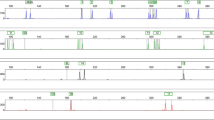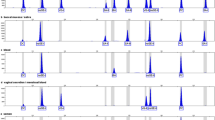Abstract
Analysis of genetic markers can provide clues for case investigation. Short tandem repeat (STR) detection and analysis are widely used for both personal identification and parentage testing. However, DNA analysis currently cannot provide sufficient information for body fluid identification. Tissue or cell sources of samples can be identified by detecting body fluid-specific mRNA markers, which have been studied thoroughly. Integrating STR profiling and mRNA expression patterns can provide more information than conventional methods for investigations and the reconstruction of crime scenes; this can be achieved by DNA/RNA co-extraction technology, which is economical, efficient, and suitable for low-template samples. Here, we propose a co-analysis system based on the PowerPlex 16 kit. This system can simultaneously amplify 25 markers, including 15 STRs, one non-STR amelogenin, and nine mRNA markers (three blood-specific, two saliva-specific, two semen-specific, and two housekeeping gene markers). The specificity and sensitivity of the co-analysis system were determined and aged and degraded samples were used to validate the stability of the co-analysis system. Finally, different DNA/RNA ratios and various carriers were evaluated. The results showed that the DNA/RNA co-analysis system correctly identified different types of body fluid stains. The STR profiles obtained using the co-analysis system were identical to those obtained using the PP16 kit, which demonstrates that the mRNA primers used did not affect STR profiling. Complete STR and mRNA profiles could be obtained from 1/8 portions of buccal swabs, 1/16 portions of swabs of blood and semen samples, 0.1 cm2 of blood samples, 0.25 cm2 of semen samples, and 1.0 cm2 saliva samples. Additionally, our findings indicate that complete STR and mRNA profiles can be obtained with this system from blood and semen samples when the DNA/RNA ratio is 1:1/32. This study suggests that the co-analysis system could be used for simultaneous personal identification and body fluid identification.





Similar content being viewed by others
Data availability
All data generated or analysed in this study were included in the article and supplementary material.
Materials availability
All data generated or analysed in this study were included in the article and supplementary material.
Code availability
None.
References
Gymrek M (2017) A genomic view of short tandem repeats. Curr Opin Genet Dev 44:9–16
Xu Z et al (2018) Development of forensic DNA analysis and investigation of common STR kits. Chin J Birth Health Hered 26(11):1–2+5
Song F et al (2009) Tissue specific differentially methylated regions (TDMR): changes in DNA methylation during development. Genomics 93(2):130–139
Lee HY et al (2012) Potential forensic application of DNA methylation profiling to body fluid identification. Int J Legal Med 126(1):55–62
Choi A et al (2014) Body fluid identification by integrated analysis of DNA methylation and body fluid-specific microbial DNA. Int J Legal Med 128(1):33–41
Horvath S, Raj K (2018) DNA methylation-based biomarkers and the epigenetic clock theory of ageing. Nat Rev Genet 19(6):371–384
Law PP, Holland ML (2019) DNA methylation at the crossroads of gene and environment interactions. Essays Biochem 63(6):717–726
Liu C et al (2018) DNA Methylation and psychiatric disorders. Prog Mol Biol Transl Sci 157:175–232
Hong SR et al (2017) DNA methylation-based age prediction from saliva: high age predictability by combination of 7 CpG markers. Forensic Sci Int Genet 29:118–125
Laubach ZM et al (2021) Early-life social experience affects offspring DNA methylation and later life stress phenotype. Nat Commun 12(1):4398
Hanson EK, Lubenow H, Ballantyne J (2009) Identification of forensically relevant body fluids using a panel of differentially expressed microRNAs. Anal Biochem 387(2):303–314
Zubakov D et al (2010) MicroRNA markers for forensic body fluid identification obtained from microarray screening and quantitative RT-PCR confirmation. Int J Legal Med 124(3):217–226
Courts C, Madea B (2011) Specific micro-RNA signatures for the detection of saliva and blood in forensic body-fluid identification. J Forensic Sci 56(6):1464–1470
Mori MA et al (2019) Extracellular miRNAs: from biomarkers to mediators of physiology and disease. Cell Metab 30(4):656–673
Zhang Y et al (2018) Evaluation of the inclusion of circular RNAs in mRNA profiling in forensic body fluid identification. Int J Legal Med 132(1):43–52
Song F et al (2017) Microarray expression profile of circular RNAs in human body fluids. Forensic Sci Int: Genet Suppl Series 6:e55–e56
Xia S et al (2017) Comprehensive characterization of tissue-specific circular RNAs in the human and mouse genomes. Brief Bioinform 18(6):984–992
Bauer M, Kraus A, Patzelt D (1999) Detection of epithelial cells in dried blood stains by reverse transcriptase-polymerase chain reaction. J Forensic Sci 44(6):1232–1236
Nussbaumer C, Gharehbaghi-Schnell E, Korschineck I (2006) Messenger RNA profiling: a novel method for body fluid identification by real-time PCR. Forensic Sci Int 157(2–3):181–186
Haas C et al (2011) Selection of highly specific and sensitive mRNA biomarkers for the identification of blood. Forensic Sci Int Genet 5(5):449–458
Albani PP, Fleming R (2018) Novel messenger RNAs for body fluid identification. Sci Justice 58(2):145–152
Wang Z et al (2013) Messenger RNA profiling for forensic body fluid identification: research and applications. Fa Yi Xue Za Zhi 29(5):368–374
Ingold S et al (2018) Body fluid identification using a targeted mRNA massively parallel sequencing approach - results of a EUROFORGEN/EDNAP collaborative exercise. Forensic Sci Int Genet 34:105–115
Haas C et al (2014) RNA/DNA co-analysis from human menstrual blood and vaginal secretion stains: results of a fourth and fifth collaborative EDNAP exercise. Forensic Sci Int Genet 8(1):203–212
Haas C et al (2013) RNA/DNA co-analysis from human saliva and semen stains–results of a third collaborative EDNAP exercise. Forensic Sci Int Genet 7(2):230–239
Haas C et al (2012) RNA/DNA co-analysis from blood stains–results of a second collaborative EDNAP exercise. Forensic Sci Int Genet 6(1):70–80
Haas C et al (2015) RNA/DNA co-analysis from human skin and contact traces–results of a sixth collaborative EDNAP exercise. Forensic Sci Int Genet 16:139–147
Haas C et al (2011) mRNA profiling for the identification of blood–results of a collaborative EDNAP exercise. Forensic Sci Int Genet 5(1):21–26
van den Berge M et al (2014) A collaborative European exercise on mRNA-based body fluid/skin typing and interpretation of DNA and RNA results. Forensic Sci Int Genet 10:40–48
Salzmann AP et al (2021) mRNA profiling of mock casework samples: results of a FoRNAP collaborative exercise. Forensic Sci Int Genet 50:102409
Lindenbergh A et al (2012) A multiplex (m)RNA-profiling system for the forensic identification of body fluids and contact traces. Forensic Sci Int Genet 6(5):565–577
Juusola J, Ballantyne J (2007) mRNA profiling for body fluid identification by multiplex quantitative RT-PCR. J Forensic Sci 52(6):1252–1262
Xu Y et al (2014) Development of highly sensitive and specific mRNA multiplex system (XCYR1) for forensic human body fluids and tissues identification. PLoS One 9(7):e100123
Song F, Luo H, Hou Y (2015) Developed and evaluated a multiplex mRNA profiling system for body fluid identification in Chinese Han population. J Forensic Leg Med 35:73–80
Zubakov D et al (2008) Stable RNA markers for identification of blood and saliva stains revealed from whole genome expression analysis of time-wise degraded samples. Int J Legal Med 122(2):135–142
Zhao H et al (2017) Identification of aged bloodstains through mRNA profiling: Experiments results on selected markers of 30- and 50-year-old samples. Forensic Sci Int 272:e1–e6
Juusola J, Ballantyne J (2005) Multiplex mRNA profiling for the identification of body fluids. Forensic Sci Int 152(1):1–12
Steger K et al (2000) Expression of protamine-1 and -2 mRNA during human spermiogenesis. Mol Hum Reprod 6(3):219–225
Bauer M, Patzelt D (2003) Protamine mRNA as molecular marker for spermatozoa in semen stains. Int J Legal Med 117(3):175–179
Fleming RI, Harbison S (2010) The development of a mRNA multiplex RT-PCR assay for the definitive identification of body fluids. Forensic Sci Int Genet 4(4):244–256
Sabatini LM, Ota T, Azen EA (1993) Nucleotide sequence analysis of the human salivary protein genes HIS1 and HIS2, and evolution of the STATH/HIS gene family. Mol Biol Evol 10(3):497–511
Li H et al (2012) A novel application of cell-free seminal mRNA: non-invasive identification of the presence of germ cells or complete obstruction in men with azoospermia. Hum Reprod 27(4):991–997
Haas C et al (2009) mRNA profiling for the identification of sperm and seminal plasma. Forensic Sc Int: Genet Suppl Series 2(1):534–535
Sabatini LM, Azen EA (1989) Histatins, a family of salivary histidine-rich proteins, are encoded by at least two loci (HIS1 and HIS2). Biochem Biophys Res Commun 160(2):495–502
Vallone PM, Butler JM (2004) AutoDimer: a screening tool for primer-dimer and hairpin structures. Biotechniques 37(2):226–231
Juusola J, Ballantyne J (2003) Messenger RNA profiling: a prototype method to supplant conventional methods for body fluid identification. Forensic Sci Int 135(2):85–96
Jucker R et al (2015) In-house validation of an RNA/DNA co-extraction strategy for body fluid identification/STR profiling and application to forensic casework. Forensic Sci Int: Genet Suppl Series 5:e381–e383
Peng D et al (2020) Postmortem interval determination using mRNA markers and DNA normalization. Int J Legal Med 134(1):149–157
Funding
This study was supported by the Sichuan University and Luzhou Municipal People’s Government Strategic cooperation projects (no. 2020CDLZ-7) and the National Natural Science Foundation of China (no.82002004).
Author information
Authors and Affiliations
Corresponding authors
Ethics declarations
Ethics approval
This study was approved by the Ethics Committee at Sichuan University.
Consent to participate
Written informed consent was obtained from all sample donors.
Conflict of interest
The authors declare no competing interests.
Additional information
Publisher's note
Springer Nature remains neutral with regard to jurisdictional claims in published maps and institutional affiliations.
Supplementary Information
Below is the link to the electronic supplementary material.
Rights and permissions
Springer Nature or its licensor holds exclusive rights to this article under a publishing agreement with the author(s) or other rightsholder(s); author self-archiving of the accepted manuscript version of this article is solely governed by the terms of such publishing agreement and applicable law.
About this article
Cite this article
Xiao, Y., Chen, D., Peng, D. et al. Establishment of a co-analysis system for personal identification and body fluid identification: a preliminary report. Int J Legal Med 136, 1565–1575 (2022). https://doi.org/10.1007/s00414-022-02886-y
Received:
Accepted:
Published:
Issue Date:
DOI: https://doi.org/10.1007/s00414-022-02886-y




